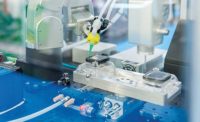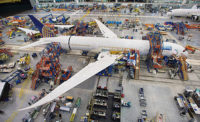Justifying automation has never been easier. The Covid pandemic, coupled with a severe worker shortage, a widening skills gap and the “great resignation,” has increased demand for automated guided vehicles, conveyors, robots and other types of equipment.
Industry 4.0 technology, such as artificial intelligence, augmented reality and data analytics, has also made it easier for manufacturers to automate production processes that have traditionally involved manual work.
Today, the upfront costs related to automation are lower than in the past. Traditional barriers to automation have fallen. Factory automation has become more accessible, easier to implement and more flexible.
However, some manufacturers still hesitate to automate due to concerns over cost, complexity, employee anxiety or return on investment. Any investments in automation need to be carefully justified by engineers.
“In the old days, it was all about labor reduction,” says Joe Campbell, senior manager of strategic marketing and applications development at Universal Robots A/S (UR). “That was the only way you justified a project. Now, there’s a lot more focus on connecting automation to business problems. It’s less about saving labor and more about freeing labor up to work on higher value processes.
“There’s also a big quality component,” notes Campbell. “More companies realize that if they can’t boost quality or increase their capacity sufficiently to continue to meet their customer’s needs, they’re at risk of losing that customer.
“Justifying big multimillion investments is still a difficult challenge for engineers, but it’s becoming very straightforward for incremental investments,” claims Campbell.
According to Jon Van Wyck, managing director and partner at the Boston Consulting Group Inc., there’s been a fundamental shift in how manufacturers regard automation. “More and more, companies are looking at factors such as ergonomics, quality and yield to justify automation instead of just labor costs,” he points out.
“Typically, manufacturers invest in robotics to address issues related to accuracy, repetitive tasks and safety,” adds Tim Paton, general industrial and electronics operations manager at ABB Robotics. “The biggest mistake someone can make is thinking of automation as only a manpower reduction opportunity.
“If you go in with that kind of a mindset, you’ll miss out on a lot of the benefits that come from investing in automation,” warns Paton. “It’s no longer just about replacing humans with machines. It’s more about doing things more efficiently and more effectively, while increasing product quality.”
Traditionally, automation was designed for repetitive manufacturing operations with few human workers in the loop. In contrast, today’s focus on collaborative automation is designed with the notion of working “next to” vs. “instead of” a human worker.
“This makes cobots ideal for short-run, variable processes where they can help a human worker complete a task more efficiently and effectively,” says UR’s Campbell. “This fundamental change requires a new model that is less focused on labor avoidance. Understanding the differences between collaborative and traditional automation is an important basis for this new model.”
The ROI Model Has Changed
As businesses around the globe navigate the repercussions of COVID-19 and supply chain interruptions, automation has emerged as a critical strategy to ensure business continuity. With an uncertain economic future, making effective return-on-investment (ROI) calculations has become more important than ever.
“Automation project decisions are complex,” says Campbell. “Deployment risk, operational risk, ongoing maintenance requirements and worker anxiety must be weighed against the flexibility, scalability, cost avoidance and occupational health benefits of automation. With all the factors to be considered, typical ROI tools used to make these decisions can feel inadequate.
“Traditional ROI and break-even point analyses are easy to understand, but only account for labor cost savings using static, long-term assumptions to measure expected outcomes,” warns Campbell. “In today’s volatile business environment, these methods can lead decision-makers to an outcome that is inconsistent with strategic objectives or that is tied to unrealistic expectations of business stability.
“Manufacturers that use traditional ROI tools to justify their improvement projects risk more by using a model that can cause enterprises to become defensive and hesitant in volatile times,” argues Campbell.
“The advent of collaborative automation gives manufacturers new opportunities to calculate ROI,” explains Campbell. “These proven quantification methods use operational key performance indicators to help a manufacturer decide how to prioritize automation projects in today’s uncertain world.”
However, Campbell believes that old-school justification worksheets still play an important role in the process. He recommends using a simple spreadsheet that gathers detailed cost information (or conservative estimates based on industry standards) related to things such as annual production volume, capacity gains, floor space savings, inventory reduction, rework savings, scrap savings and warranty savings.
Identify ‘Pain Points’
One of the best places to start an automation justification project is by identifying “pain points,” which can be everything from equipment maintenance and unscheduled downtime to material shortages and supply chain disruptions.
“Every company has a different pain point or problem on their assembly line,” says John Tuohy, national account manager at Fanuc America Corp. “It can be things such as people, quality or throughput.
“You need to look at what your pain point is, the goal you’re trying to accomplish and how automation can possibly help you,” explains Tuohy. “Since more and more people don’t want to work in factories, robots will have to fill that need.”
“The biggest pain point for most manufacturers today is the severe labor shortage,” adds Matt Charles, sales director at Mobile Industrial Robots A/S. “That makes it easier for engineers to justify automation investments. I spoke to someone recently who told me that their HR costs have gone up because they have to continually hire temp workers to address staffing issues related to people not showing up for work or quitting.”
According to the National Association of Manufacturers, the sector currently has more than 1 million job openings. And, by the end of this decade, that number could top 2 million.
“To identify pain points, you need to look at your current production challenges,” says Frank Langro, director of product market management for pneumatic automation at Festo Corp. “Automation can be a solution to issues related to consistency, safety and throughput. With the current worker shortage, many companies are also looking at ways they can redeploy their employees to handle value-added tasks.
“When justifying automation, engineers should address three things: why you want to automate; what challenges you want to overcome; and where you want to improve,” Langro points out. “Be sure to look at the entire process, including how automation will impact both upstream and downstream processes.”
Robot Rental Reduces Barriers
Cost is the No. 1 reason why manufacturers shy away from investing in automation. However, the robots-for-hire business model is changing that misperception. Large and small manufacturers in a wide variety of industries are beginning to treat robots as “temp workers.” It’s part of a new robotics-as-a-service trend.
“Robotics-as-a-service is a way for manufacturers to cost-effectively adopt automation,” says Fanuc’s Tuohy. “Instead of making a large investment in the capital, a company invests in the process. It works similar to contract manufacturing. Although products are built on your factory floor, you don’t own the equipment.”
The concept especially appeals to small- and medium-sized manufacturers, because a third-party vendor handles every aspect of financing, deploying and maintaining robots.
“Traditionally, manufacturers buy robots, which is a lengthy, complex, inflexible and expensive process,” notes Saman Farid, CEO of Formic Technologies, a new company that “rents” robots from companies such as ABB, Fanuc and UR. “These barriers to entry are so high for smaller manufacturers that they often refrain from deploying automation altogether.”
Farid claims that his company “delivers customized robots at a low hourly rate with no money upfront and guaranteed uptime.” He says deployments are 50 percent faster than traditional approaches and save customers 42 percent on their operating expenses from the first day.
“We provide a way for any manufacturer to easily adopt automation in a simple, risk-free and on-demand way,” explains Farid. “Manufacturers can do more with automation without high costs or a lengthy and complicated purchasing and deployment process.”
One company that is bullish on the concept is Polar Hardware Manufacturing Co. The 105-year-old firm on the North Side of Chicago produces handles, hinges, latches, locks, vents and other types of metal parts used for doors and truck bodies. It recently worked with Formic to automate its factory for the first time. The application uses a URe collaborative robot to feed a press brake.
Polar Hardware was struggling to meet its production goals and fill orders. “If [we] didn’t automate, we would be out of business,” says Jose Figuerao, plant manager. ”We cannot compete if we cannot produce.”
The machine tending system can produce 750 parts every 10 hours, which saves about $77,000 a year in labor costs. Engineers can monitor system performance from Formic’s platform, which delivers analytics in real time.
Polar Hardware recently signed another contract with Formic to add a spot welding robot. The company is also considering moving from a two-shift to a three-shift operation, which would enable the cobots to run around the clock. With both systems up and running, Figuerao expects to save around $150,000 per year in operation costs.










